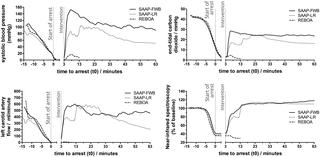PLOS Medicine ( IF 15.8 ) Pub Date : 2017-07-25 , DOI: 10.1371/journal.pmed.1002349 Ed B. G. Barnard , James E. Manning , Jason E. Smith , Jason M. Rall , Jennifer M. Cox , James D. Ross

|
Background
Survival rates remain low after hemorrhage-induced traumatic cardiac arrest (TCA). Noncompressible torso hemorrhage (NCTH) is a major cause of potentially survivable trauma death. Resuscitative Endovascular Balloon Occlusion of the Aorta (REBOA) at the thoracic aorta (Zone 1) can limit subdiaphragmatic blood loss and allow for IV fluid resuscitation when intrinsic cardiac activity is still present. Selective Aortic Arch Perfusion (SAAP) combines thoracic aortic balloon hemorrhage control with intra-aortic oxygenated perfusion to achieve return of spontaneous circulation (ROSC) when cardiac arrest has occurred.
Methods and findings
Male Yorkshire Landrace cross swine (80.0 ± 6.0 kg) underwent anesthesia, instrumentation for monitoring, and splenectomy. TCA was induced by laparoscopic liver lobe resection combined with arterial catheter blood withdrawal to achieve a sustained systolic blood pressure <10 mmHg, cardiac arrest. After 3 min of arrest, swine were allocated to one of three interventions: (1) REBOA plus 4 units of IV fresh whole blood (FWB), (2) SAAP with oxygenated lactated Ringer’s (LR), 1,600 mL/2 min, or (3) SAAP with oxygenated FWB 1,600 mL/2 min. Primary endpoint was survival to the end of 60 min of resuscitation, a simulated prehospital phase. Thirty animals were allocated to 3 groups (10 per group)—5 protocol exclusions resulted in a total of 35 animals being used. Baseline measurements and time to cardiac arrest were not different amongst groups. ROSC was achieved in 0/10 (0%, 95% CI 0.00–30.9) REBOA, 6/10 (60%, 95% CI 26.2–87.8) SAAP-LR and 10/10 (100%, 95% CI 69.2–100.0) SAAP-FWB animals, p < 0.001. Survival to end of simulated 60-minute prehospital resuscitation was 0/10 (0%, 95% CI 0.00–30.9) for REBOA, 1/10 (10%, 95% CI 0.25–44.5) for SAAP-LR and 9/10 (90%, 95% CI 55.5–99.7) for SAAP-FWB, p < 0.001. Total FWB infusion volume was similar for REBOA (2,452 ± 0 mL) and SAAP-FWB (2,250 ± 594 mL). This study was undertaken in laboratory conditions, and as such may have practical limitations when applied clinically. Cardiac arrest in this study was defined by intra-aortic pressure monitoring that is not feasible in clinical practice, and as such limits the generalizability of findings. Clinical trials are needed to determine if the beneficial effects of SAAP-FWB observed in this laboratory study will translate into improved survival in clinical practice.
Conclusions
SAAP conferred a superior short-term survival over REBOA in this large animal model of hemorrhage-induced traumatic cardiac arrest with NCTH. SAAP using an oxygen-carrying perfusate was more effective in this study than non-oxygen carrying solutions in TCA. SAAP can effect ROSC from hemorrhage-induced electrocardiographic asystole in large swine.
中文翻译:

选择性主动脉弓灌注和主动脉复苏性血管内球囊阻塞治疗出血性创伤性心脏骤停的比较:大猪的转化模型
背景
出血引起的创伤性心脏骤停(TCA)后,存活率仍然很低。不可压缩的躯干出血(NCTH)是潜在的可生存的创伤死亡的主要原因。胸主动脉(第1区)的主动脉复苏性血管内球囊闭塞(REBOA)可以限制dia下失血量,并且当仍然存在内在的心脏活动时可以进行IV液体复苏。选择性主动脉弓灌注(SAAP)将胸主动脉球囊出血控制与主动脉内含氧灌注结合在一起,以在发生心脏骤停时恢复自发循环(ROSC)。
方法和发现
对雄性约克郡长白猪(80.0±6.0 kg)进行麻醉,监测仪器和脾切除术。腹腔镜肝叶切除术结合动脉导管抽血诱导TCA,使收缩压持续<10 mmHg,心跳骤停。逮捕3分钟后,将猪分配给以下三种干预措施之一:(1)REBOA加上4单位的IV静脉全血(FWB),(2)SAAP与含氧乳酸林格氏液(LR),1,600 mL / 2 min,或(3)含氧FWB 1600 mL / 2 min的SAAP。主要终点是生存至复苏前的60分钟(模拟的院前阶段)。将30只动物分为3组(每组10个),其中5个方案排除在外,总共使用了35只动物。各组之间的基线测量值和心脏骤停时间没有差异。p<0.001。对于REBOA,模拟的60分钟院前复苏结束后生存率为0/10(0%,95%CI 0.00-30.9),对于SAAP-LR为1/10(10%,95%CI 0.25-44.5),而9/10 SAAP-FWB(90%,95%CI 55.5-99.7),p <0.001。REBOA(2,452±0 mL)和SAAP-FWB(2,250±594 mL)的总FWB输注量相似。这项研究是在实验室条件下进行的,因此在临床应用时可能会有实际的局限性。该研究中的心脏骤停是通过主动脉内压力监测来定义的,在临床实践中这是不可行的,因此限制了研究结果的推广性。需要进行临床试验以确定在此实验室研究中观察到的SAAP-FWB的有益效果是否将转化为临床实践中改善的生存期。
结论
在这种出血引起的NCTH引起的创伤性心脏骤停的大型动物模型中,SAAP的短期生存期优于REBOA。在本研究中,使用载氧灌注液的SAAP比TCA中的非载氧溶液更有效。SAAP可以通过大猪出血引起的心电停搏来影响ROSC。


























 京公网安备 11010802027423号
京公网安备 11010802027423号